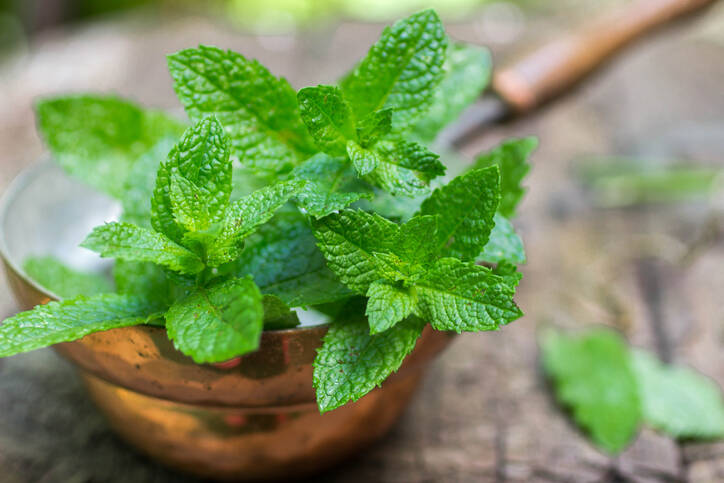- Recipes from the home pharmacy,
- Health from herbs , Verified recipes of a favourite herbalist (Anna Kopáčová),
- Mini manual of herbs (Tatiana Plesova),
- Herbs of the Czech Garden (Petra Rubášová).
Mint and its health benefits. How to use and grow it?

Photo source: Getty images
Mint is popular in every household and can be used in many ways. You can also easily grow it at home.
Characteristics
It's a fragrant herb popular in summer and winter. It's good in hot and cold drinks, and cooks can use it in cooking and baking.
It is a hardy herb that can grow up to 80 cm tall.
Its leaves have a scalloped edge and are fragrant to the touch. The flowers are purple in colour and are arranged in horsetails forming dense terminal heads.
There are many varieties, such as leaf mint, lance mint, water mint and curly mint.
It is a very undemanding herb, which some even describe as a weed. Once planted, it is easy to take up, self-seeding and spreading.
Interestingly, in some countries it is sown to keep away flies.
Our grandmothers already used it in home medicine, especially for colds and similar respiratory ailments.
It is also an excellent remedy for gall bladder, stomach and intestinal disorders. Our grandmothers used it as a remedy for vomiting, lack of appetite.
Grandmothers recommended it for problems with hard breasts during breastfeeding.
If you would like to give someone a mint, you will be expressing friendship and love, as it is their symbol.
It also helps with digestive problems in young children. It will help reduce their appetite and calm their digestion.
It is not recommended for pregnant women and babies, so be very careful with the dosage.
It contains essential oils. Up to half of them are menthol, which is so pronounced.
It also contains tannins, which have diverse effects, such as antimicrobial, antioxidant. They contribute to overall good immunity and also to lowering blood pressure.
Its name is said to derive from the mythical river nymph Minthé, who took a great liking to the god of the underworld, Hades. This is said to have displeased his wife, so she turned Minthé into a plant. Minthé turned into a fragrant and medicinal herb that Hades could still smell.
Mint is also rich in flavonoids and other substances that make it fragrant, tasty and so beneficial to our health.
Because of its composition and especially the menthol it contains, it is also used to freshen the breath or to rinse the mouth. It also helps with mild toothaches.
It is also used in the manufacture of toothpastes, whether homemade or industrial.
Mint is also said to be an aphrodisiac.
Internal use
Mint provides us with protein, potassium, phosphorus, magnesium, manganese, copper, carbohydrates, sodium, fat, fibre, iron, calcium, zinc, omega 3 and 6 unsaturated fatty acids and vitamins A, B, C.
For example, mint tea is excellent. This is simply prepared by pouring hot water over fresh and washed leaves. Honey and lemon can be added.
Such a tea should be drunk twice a day to help against indigestion and calm nervousness.
It also has a positive effect on the peristalsis of the intestines, which will also help with winds and bloating.
Peppermint tea will also boost your appetite. It can also help in reducing fever.
It can also be used in fruit salads. Just chop it and add it to your salad.
We recommend chopping apples, strawberries, mango and banana. Mix the chopped mint with yogurt and chia seeds and pour the mixture over the fruit. Such a salad is a great source of energy, especially in the morning, even during flu season.
External use
Rubbing mint extract into painful areas of muscles and joints is also excellent. Its use is also suitable for relaxing and refreshing baths.
The oil or water infusion can also be used for facial masks, the skin will be cleaner and softer.
Athletes can use a wrap or massage peppermint oil into sore or inflamed muscles. This will help with muscle fever or cramps.
Peppermint oil also helps with tension or headaches. It will help if you massage it into your sleeping area.
Soaking over warm peppermint tea is also recommended.
Breastfeeding moms can use a mint poultice to help with breast pain. Make a poultice of milk, mint oil or brine, white spirit and a little cold water. Mix everything together, soak a diaper or washcloth and apply to the breasts.
But if you have problems with your breasts, you need to see a doctor first!
Harvesting and storage
We collect mint leaves and twigs mainly in the dry season and shortly before flowering.
We use it fresh, directly from the pot or from the garden.
The ancient Romans used mint leaves in liqueurs or cooked them into compotes.
Its dried leaves have also been found in thousands of years old Egyptian tombs.
It is best to dry it in a warm place out of sunlight. Lay it on an airy cloth or netting by spreading the leaves out side by side. They should not be stacked on top of each other to dry properly. It can also be tied into smaller bundles and dried in a well-ventilated, dry place, tied by the stems, with the flowers pointing downwards.
The dried herb can be stored dry and in a paper or cloth bag. Stored mint will make us happy even in winter.
However, it can also be stored in the freezer, but it should be used straight from the freezer, not thawed. Otherwise it will wilt and cannot be used at all.
Mint in the garden
The herb is best placed in a sunny spot with plenty of space, as it likes to grow easily.
It needs to be watered sufficiently, but not too much. If it establishes itself well, leave it to nature. If it is very dry, water it only occasionally.
In autumn, it is advisable to cut it back to a height of about 15 cm. It does not need to be protected in winter. It should not freeze.
Interesting resources

Mgr. Simona Morvayová
Editor
I finished my studies at the University of Constantine the Philosopher in Nitra with a Master's degree. I studied for five years in the field of Slovak language teaching combined with ethics education.
I am currently working in the media field, where I manage two portals related to health and healthy eating, among other things.
My passion for food and healthy meals dates back to high school. Having studied five years at a hotel high school, I have a long-standing relationship with food and new recipes. I love to cook and invent new recipes, which mostly have to be healthy and full of vitamins. In the case of cooking, it really is my passion.
The modern world brings many possibilities and topics that can be addressed through food. I am also interested in gluten-free and lactose-free recipes. My own health issues, but also a celiac in the family, led me to these recipes.
My other hobbies besides working and cooking are relaxing with yoga and running.
View all articles by the same authorThe aim of the portal and content is not to replace professional
examination. The content is for informational and non-binding purposes
only, not advisory. In case of health problems, we recommend seeking
professional help, visiting or contacting a doctor or pharmacist.









